Croatia
General
Independent democratic republic, member of the EU since 2013, Croatia stretches down the Adriatic coast from Slovenia to Albania, with a large inland mass. Its 56,000 square kilometres contain a population of just over 4 million, divided into 20 counties plus the capital, Zagreb.
Tourism forms 20% of Croatia's GDP, and is a significant industry. The bulk of the country's 12 million tourists a year head for the Adriatic coast, with numerous nature reserves, unpolluted marine areas, and 116 Blue Flag beaches. The water is clear and visibility is good.
It gets hot in the summer - 32 to 34 degrees Centigrade.
Currency: Kuna (HRK).
1HRK = £0.12. = €0.14 = US$ 0.16
Flight time London to Croatia : about 2 hrs 20 min. If you want to drive from Calais to Croatia, it takes about 19 hours to the North.
Going all the way south to Dubrovnik, be aware that neighbouring Bosnia-Herzegovina stretches a toenail into the Adriatic at Nuem, bisecting the access. You'll need special insurance, as Bosnia-Herzegovina is not a member of the EU.
Time in Croatia: UTC + 02.00
Entry requirements: valid passport, return ticket.
Visas? Not for EU, US, Canada, Australia, new Zealand, but needed for certain countries. See
http://www.visit-croatia.co.uk/index.php/information-on-croatia/visa-requirements-for-croatia/
written August 2017
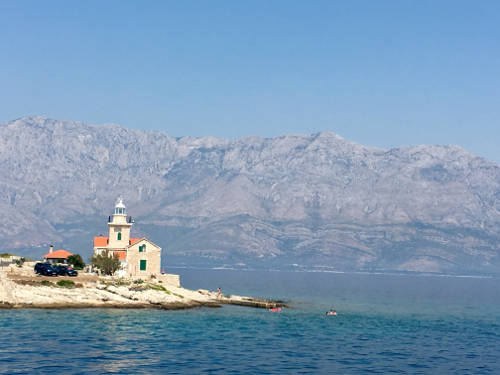

Climate charts (for Split)
June, July, August and September have warm air and sea temperatures (20 to 23 degrees Centigrade is a warm sea in this part of the world) and the smallest rainfall.
UK Foreign office carried no warnings about Croatia in August 2017. They point out there is minimal tolerance of drinking alcohol while in charge of a boat, which is a good thing: less chance of being mown down by a drunken yahoo when you're in the water.
15% of tourists to Croatia are naturists: it's very popular here.
More information - http://www.split.climatemps.com , http://www.holiday-weather.com/split/averages/
Croatia visits
Introduction
Snorkelling in the Med and the Adriatic on a good day is fantastic. The water is clear and warm, there are loads of fish around, and you have a wonderful time. We saw our first octopus in the Mediterranean, and it was just brilliant. Once you see an octopus sidling across the rocks, folding and unfolding in three-dimensional origami, you never forget it. I can see it now.
The Adriatic can be stunning: magnificent clear water, blue skies, and warm weather. There are loads of fish, but not so much colour as in, say, the Red Sea. To read a good introduction about snorkelling in the Adriatic, read Frank G's Snorkelling in Croatia -http://www.frankaboutcroatia.com/snorkeling-in-croatia/#Pros-Cons-of-snorkeling-in-Croatia
- it's a good explanation of what to expect, and it recommends places to go.
Croatia is a heart-wrenchingly beautiful country, with hot dusty green landscapes and mind-bogglingly picturesque beaches, friendly people and great food. It's a little far for Brits to drive, so they tend to think of it as “There Be Dragons” country - but actually, driving to the islands is about the same distance as driving to Naples, Lisbon or Alicante. It can be done, and it is worth the trip. Dubrovnik is becoming a very popular tourist destination, and Zagreb is well worth a visit.
If you drive down from the UK, you'll expect to pay about £100 to go through the autoroutes in France, but you can avoid this by going (for free) through the autobahn system in Germany. One thing you need to know - the central and eastern European countries are getting very keen on 'vignettes' - plastic stickers you put in your car front window. It's a form of road tax, but easy and not too expensive.
How does it work? You stop at a petrol station, or a shop at the frontier, buy a sticker for 10 to 30 euros, and put it in your windscreen. If you don't buy them - or don't display them - you can get a heavy fine. This website tells you which countries require them. http://www.dalnicni-znamky.com/en/
There are a lot... Austria, Switzerland, Slovenia, Czech Republic to name but a few.
For historical reasons, Croatia spills down most of the Dalmatian coast, and is much admired (and frequented) by Italians, Germans, Bosnians and Slovenians. This is a very popular tourist destination, which has been helped by its membership of the EU. The main roads are good and the country loves tourists. But it has a dark history. Those of you who would like to be reminded of the horrors in this country (which happened a short twenty years ago) should read Sara Novic’s excellent novel, Girl at War.
It's a snorkeller’s paradise - hot, with cool clear water and great visibility. There are a lot of different islands, which people tend to hop around. The idea is, you drive down the coast, find a ferry town, get to an island, then move on to the next one. There are 450 different ferry routes, so there is plenty of choice. www.croatiaferries.com
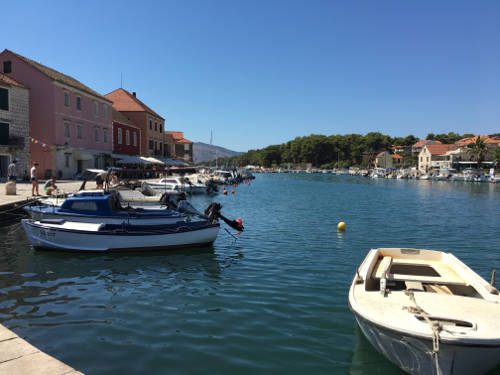
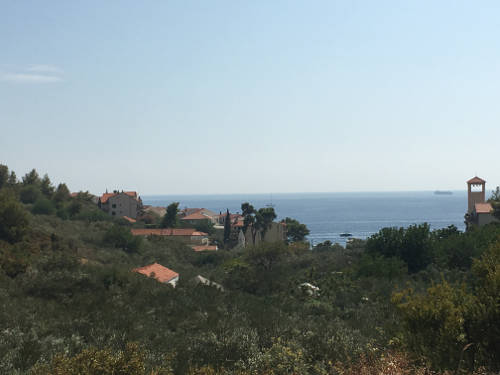


2010 visit
In 2010, we went to stay in Camp Glovotok, on the island of Krk, just south of Rijeka. It's connected by a bridge to the mainland, and we found the campsite through a book called Cool Camping - they now have a website https://coolcamping.com, which is recommended if you're looking for good spots by the sea in Europe. The camp site was excellent, and our tent was pitched 15 metres from the sea. We had a magical fortnight snorkelling two or three times a day.
Two incidents stick out: the first when we were on a dive boat in the middle of the bay. The skipper suddenly called everyone back into the boat and we raced back to the harbour, while the sky turned luminous green and the wind whipped into a fury. We just had time to tie the tent to the car wheels before the storm broke, a ferocious monster that would have carried the tent away if it hadn't had a car attached to it. So, watch out for sudden storms.
The second was the only time we got carried out by a current. We swam round a headland, and the current was too strong to swim back, so we opted for safety first, swam at ninety degrees across the current straight back to the shore, and ended up walking through an olive grove wearing snorkels and masks. Currents in Croatia can be capricious, so be aware before you go out.

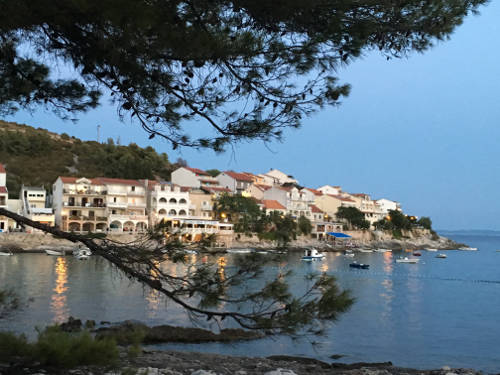


2017 trip
We may island-hop next time, but for this trip we centred on Hvar, which is gaining a reputation as the Monte Carlo of Croatia - i.e. it's where all the rich people go. We didn't find this to be the case, but if you look around you will see the rich and self-important, easing themselves around in £250,000-a-week cruise hires - so you should check the prices of hotels before you book. There are some pretty scary prices for what is still a relatively cheap country.
The only way to get to Hvar is by ferry: car ferries go from Split to Stari Grad in the north of the island, or a shorter trip from Drvenic to Sukuruc on the east - then an hour-long journey along the backbone of the island up to the the north-west.
Both ferries operate a first-come-first-served system, so get to the terminal an hour before departure, buy your ticket from the kiosk, and be prepared to wait. Two people and a small car from Drvenic to Sukuruj cost £15. The fare for two people and a small car from Hvar to Split is about £45. Jadrolinija is the name of the state ferry company that operates these routes. It's government policy to keep ferry fares cheap so that people can get to the islands. This is the ferry website: www.jadrolinija.hr
Pedestrians seem to manage OK, but for cars it's more difficult. We saw a lot of queues for car ferries to get on and off this island. You buy a ticket, but it doesn't guarantee you a place. We were advised to get in the queue two hours before getting the 11.00 am or 2.00 pm ferry from Stari Grad to Split. A lot of cars want to go to Hvar. You have been warned...
There are four or five small villages on Hvar Island, with a lot of tourists heading for Hvar Town itself. We settled on the next village across - Milna, a small hamlet clustered round a bay with a lot of holiday apartments, a £200-a-night hotel, and six restaurants.
The “Mala Milna” campsite near the village of Milna is very small - maybe 50 places - but it is close to four beaches, and costs about 50 euros a night for two adults, a car and a tent. The shores of the coast here are stony and the water is pellucid, so it's fantastic for snorkelling - but the Adriatic is Mediterranean rather than Caribbean, making the snorkelling less flamboyant and colourful.
Croatian in five days
Croatian is an easy language to learn, and the Croatians are delighted when you say a few words. If you learn five words a day, you won't get overloaded.
Day 1:
hi/goodbye: Bok
Yes: da
No: ne
Please: molim
Thank you: hvala. HVALa
Beer: piva
Day 2:
Two - dwa
Two beers please - dwa piva molim.
good morning: dobre iutro (doBRAY youtro)
Good afternoon: dobar dan (DoBARR Dan)
Good evening: dobre vecce (DobRAY vechay)
‘Dobar’ means ‘good’ - but the word changes according to the word next to it.
Day 3
How are you? Kako ste?
Fine, thank you. Dobro sam, hvala
Nice to meet you. Drago mi je. (Drago mi ye)
How much is it? Koliko kosta?
The bill, please. Rachoon, molim.
Day 4
Coffee: kava
Tea: chaia
Water: voda
Juice: soka
Wine: vina
Day 5:
One: jedan
Two: dva
Three: tri
Four: cheteree
Five: pet
.


Fish and wind
We saw a lot of annular bream, with their telltale spots: rusty-coloured damsel fish and their luminous blue young: occasionally a trigger-fish, stately like a galleon, ambling through the water with all its sails flying. Black and white zebra bream, some cleaner wrasse, and the improbably coloured Turkish wrasse that we saw the previous year on Elba. Schools of olive-coloured saupe have mysterious parties in the shallows, to which we weren’t invited: they see the snorkellers and move on to the next mysterious gathering. There are a lot of fish round here, mainly small, but sometimes some larger and very interesting specimens.
It can be hot in Croatia, so watch out for sunburn: and the wind sometimes whips up out of nowhere. It's called the bura, and is caused by pressure differential coming down from the mountains. It affects the sea and makes it choppy, and builds up speed at night. You need to tie your tent down securely.
There are two winds along the Dalmatian coast, and the locals take them very seriously. The bura comes from the north, over the Velebit mountains, a dry cool wind good for curing ham and cooling you down. It can happen any time but is most common in winter. It's the ‘good’ wind, although it can reach speeds of 190 miles an hour - hurricane force. And bura can blow in different directions. In 2012, it threw fish out of the sea on the island of Pag.
Jugo, the bad wind, is moist and blows in from the south. It brings dark clouds and rain-filled storms. It can also cause depression, and, it is believed, criminal behaviour. The last night of our camping, the jugo broke onto our campsite, smashing a tree to the ground five metres from the tent, breaking two of our tent poles, and hammering us with hail and ice for fifteen minutes while we tried to hold the tent up. And this was on the 2nd September. www.expatincroatia.com/bura
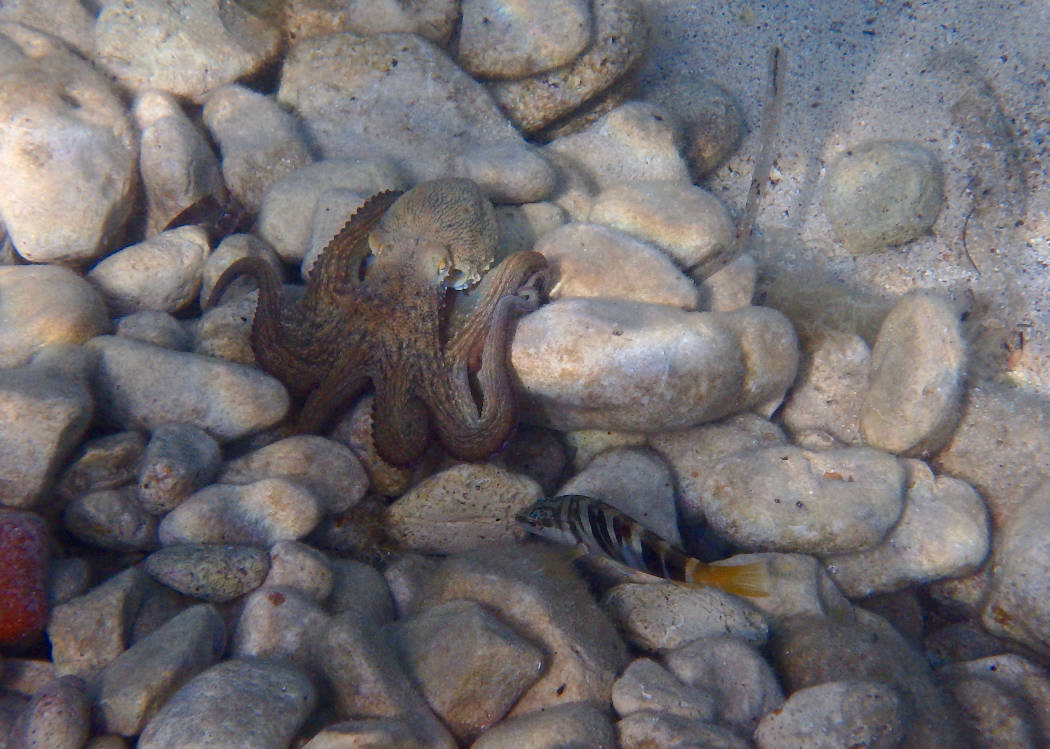
Octopus and mermaid
TODAY WE SAW AN OCTOPUS! Gill was trying to take a photo of a painted comber, as she knew about the blue splodge on its side and wanted to record it, when she saw what she thought was a cuttlefish, looking like an arrow with a huge head, travelling fast. She pointed it out. We watched as it arrowheaded its way through the water, then collapsed and unfolded onto a rock. Our ‘cuttlefish’ grew legs about 10 cms long, and a large head, and a beak, and insinuated its tentacles slowly round the rock, looking at first as if it had a parrot’s head, then a large brainy cerebellum, then a surprised expression as it inched its way past a startled wrasse, changing colour from a powdery blue underside to an olive-brown camouflage that perfectly matched the rocks and vegetation around it. As we watched, it found a hole and just disappeared into the background, so perfect was its camouflage. Gill kept snapping and snapping, not knowing if the pictures would come out - but they did. Our second octopus in ten years of snorkelling. It was fantastic.
This is why snorkelling is such great fun. You never know what will happen next. But it helps being in Croatia, where snorkelling areas in popular beaches are fenced off. Around France, if there are octopi, you see lots of people hunting them. Not here. So far...
Early morning snorkelling is the best, while the water is still silky and the fish haven't been frightened away by the swimmers and the boats. There are a lot of bream here - annular bream, two-banded bream, white bream and saddled bream. Bream City.
Went out at 9.30, saw four pipefish, some Turkish wrasse and a girl with mermaid fins on. That was weird... and another octopus. Getting good at this.



Cucumber sex
It pays to keep your eyes open for everything going on around you, not just look at the fish. Today we saw some sea cucumbers having sex. It started when we noticed what looked like a scaly black cucumber in an ‘L’ shape on the sea bottom. The upright part of the L was about 20 cms long.
As we hovered above it, trying to work out what it was, it ejected a cloud of reddish-brown smoke. It looked like an underwater factory chimney burning very dirty coal. It was a female cucumber, emitting eggs. It mixes with the white sperm ejected by males.
We looked around and saw a number of other cucumbers, all erect, all looking as if they wanted to party. They were doing everything except throw their car keys into a saucer. It was torrid.
Hvar Town
Hvar town is where it all happens on Hvar Island. This is a historic old town, with cobbled squares, ancient walkways and a lot of people offering boat trips. When we were researching this trip, we were horrified by some of the prices quoted for snorkelling trips - US $400 for a day’s trip on a boat.
These aren't very typical, however. If you walk round Hvar you see that every other shop is offering boat tours, but usually they are acting as an agent, just trying to pick up commission. We were recommended to try Viking Dive Shop, but their website doesn't mention snorkelling.
You could try Atlas Hvar who do a day’s snorkelling for €70 - http://atlas-hvar.com/iliriostours/snorkeling-tours - or you could check for other tours on the internet.
But snorkelling in Croatia is more of an individual activity. The best thing to do is just wander down to the harbour and pick up a water taxi. They sit in queues under signs saying how much they cost. They all go to the Pakleni Islands that you can see in front of the harbour.
The cheapest taxi - 40 kune, about £5 per person - goes to Jerolim and Planikovac. It's a ten-minute trip. 50 kune - about £6, goes to the islands a bit further out, and 70 kune £8, go to the furthest part. Hold on to your ticket and you’ll get a ride back on the same boat or another one - the tickets are valid across all of them. Last boat back is 7pm.
We tried it. This is a fantastic way to get a cheap boat ride to great snorkelling locations. Here’s our report from Jerolim:
Got into the water, thinking, well, deja swam, the water’s clear and the sea is blue but it's the same old fish. Then I thought, what is snorkelling about? Back home it's cold and wet and if I look up I see rows of white houses with terracotta roofs basking in the bright sunshine under the ancient castle while cruise ships and water taxis amble past. And here I am in a turquoise sea with 20 metres visibility. This is wonderful...
I looked down and a column of 2,000 sprats, four metres long and a metre wide, threaded across the ocean floor like an invading Roman army - and then Gill spotted an octopus, our third this trip, trying desperately and unsuccessfully to pretend it wasn't there.
We watched as the animal attempted to hide itself under a pile of rocks - a brown octopus trying to hide in pale grey rocks has a hard job to do - then after two or three minutes it took a chance and ran for it, its attendant wrasse running too.
Travelling over the sea bottom, it changed colour from dark brown to pale grey and hid in a pile of pale grey rocks a couple of metres away. It was fantastic, exciting, other-worldly - and only ten minutes earlier, I had been feeling blasé. You never know what's round the corner.
Back in Hvar, we checked out boat hire: up to now, it hadn't been possible for us, because Croatia requires boat licences. But you can hire a basic flat-bottom boat with outboard and canopy for 500 kune a day from kiosks in the harbour - that's about £65, and you don't need a licence.
So you can Island hop the Paklenis for a relatively small amount of money. If we had time we would have done this.
How many places do you know where a £5 water taxi takes you to a fantastic snorkelling location? Croatia is on our must-come-again list.




Would we go there again? Absolutely. We would probably try island-hopping June to September.
Useful links:
Croatia tourist office - https://croatia.hr/en-GB
There are a lot of ferry websites - try http://croatiaferries.com or http://www.jadrolinija.hr
https://www.roughguides.com/destinations/europe/croatia/
https://www.gov.uk/foreign-travel-advice/croatia
https://www.lonelyplanet.com/croatia
This local guide is good - https://www.frankaboutcroatia.com
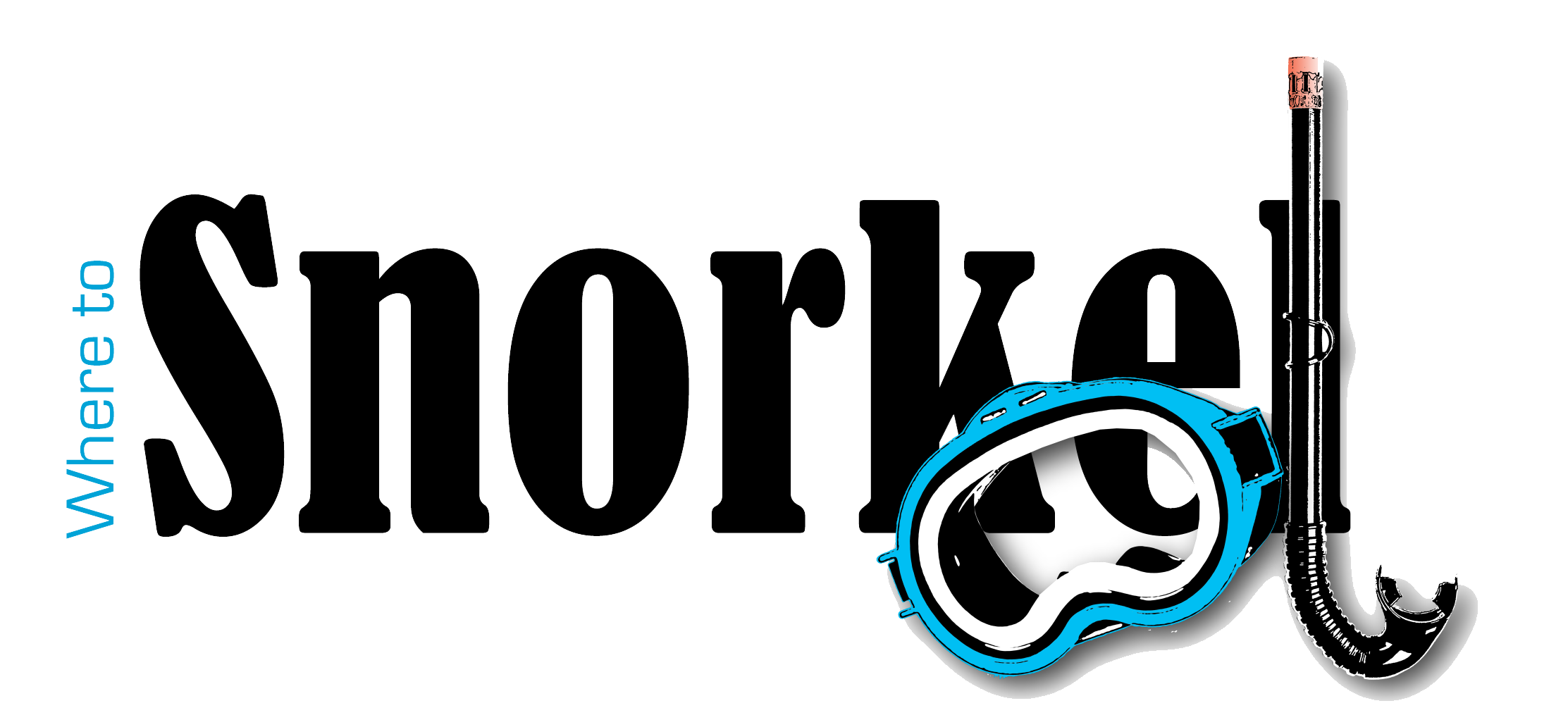
Usual warning: we have made very effort to make sure this information is correct and up-to-date, but you need to check it all yourself.
© Garreg Lwyd Ltd 2018
Do you have any comments, or recommendations? Send us a message. We'd love to hear from you!
